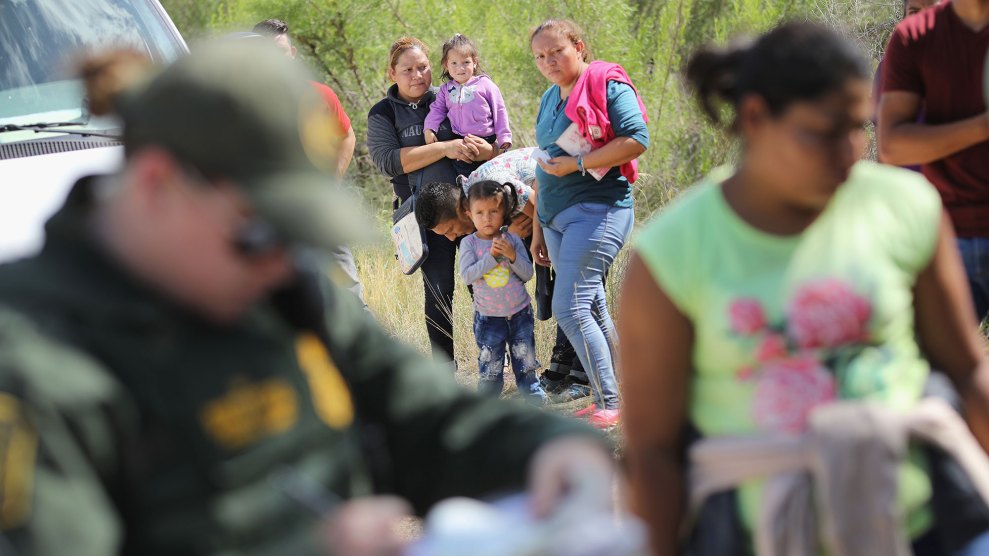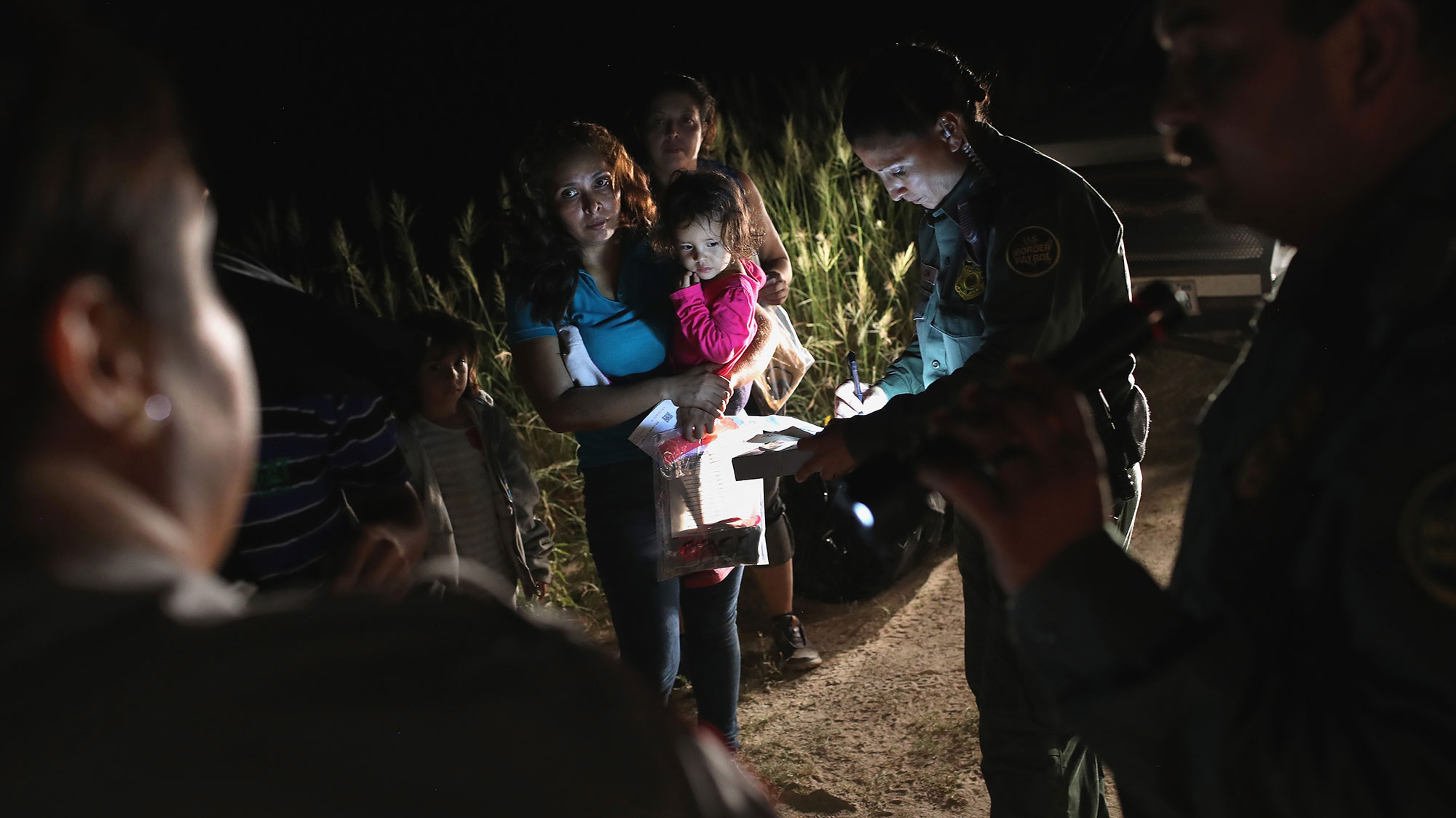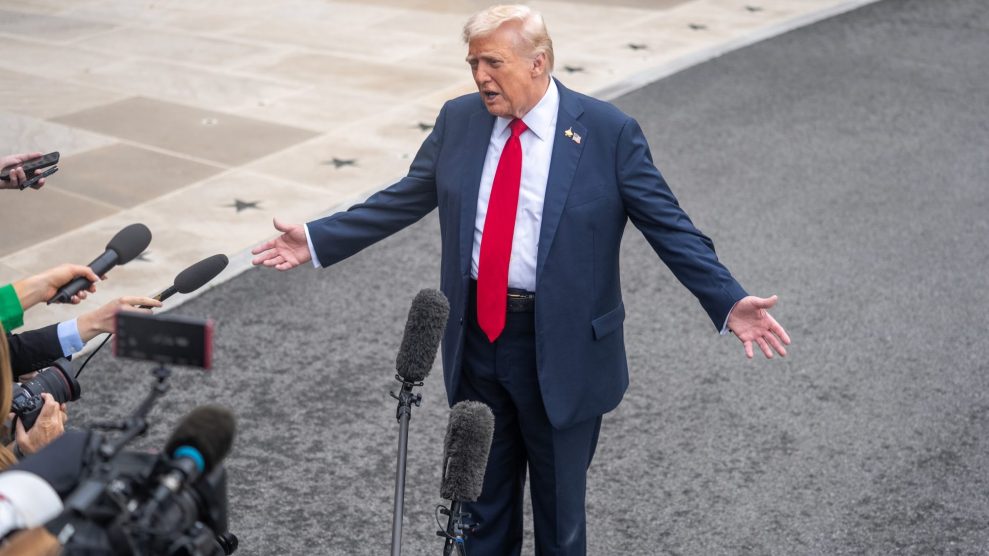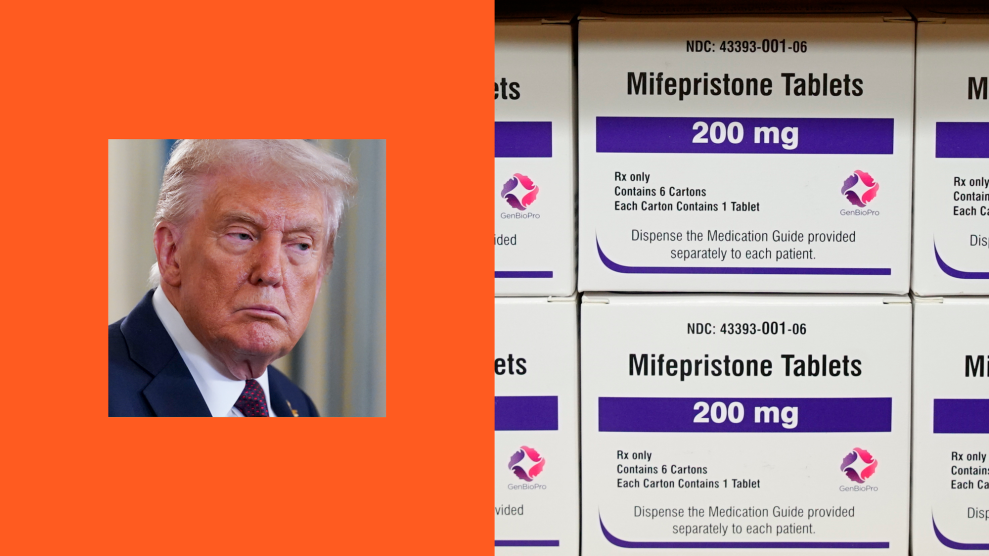
MCALLEN, TX - JUNE 12, 2018: Central American asylum seekers wait as U.S. Border Patrol agents take them into custody near McAllen, Texas. The families were then sent to a U.S. Customs and Border Protection (CBP) processing center for possible separation.John Moore/Getty Images
A yearslong investigation by the Department of Justice’s Office of Inspector General found that then–Attorney General Jeff Sessions and his senior staff rushed forward a family separation that the government was completely unprepared to implement. The combination of intentional cruelty and unintentional incompetence detailed in the report combines to create a horrifying picture of the policy that defines the Trump administration.
The OIG’s conclusion that DOJ was not ready to put in place its so-called “zero tolerance” policy has long been obvious. What makes the new report so damning is its hyper-detailed accounting of how things went wrong every step of the way. Parents spent as long as two months before talking to their kids after being separated because the government failed to create a system for keeping them in contact. Jails became dangerously overcrowded as they filled with separated parents sleeping in triple bunks. Sex offenders were released because US Marshals were overwhelmed by the policy. All the while, the Justice Department’s top leaders kept pressing for more separations.
The new investigation is based on interviews with dozens of DOJ officials, a review of roughly 200,000 emails and calendar data files, and visits to the border while the official family separation policy was still in place during the spring of 2018. It comes after similarly critical reports from the inspectors general of the departments of Homeland Security and Health and Human Services.
The report finds that Sessions “was fully aware” that this policy would result in separating children from their parents and that he was the driving force behind it. The review concludes that DOJ’s “single-minded focus” came at the expense of “careful and appropriate consideration of the impact” this would have on families, especially on children.
The story of the government’s adoption of a family separation policy starts in March 2017, when the Border Patrol’s El Paso sector started referring parents who were crossing the border with their children for prosecution by the Justice Department. The El Paso pilot project was a break from a general policy of not prosecuting parents that dated back to at least 1992.
The Justice Department had avoided prosecuting migrant parents because kids cannot be in jails while their parents await trial. The El Paso family separation pilot project led to roughly 300 parents being prosecuted, according to the new report. Those parents were traveling with 338 children, 146 of whom were age 5 or younger.
The deputy criminal chief in the El Paso region was shocked to learn what those separations looked like in practice. “We have now heard of us taking breast feeding defendant moms away from their infants,” the official wrote in August 2017. “I did not believe this until I looked at the duty log and saw the fact we had accepted prosecution on moms with one and two year olds.”
A magistrate judge in Texas identified more problems, noting:
In a number of recent illegal entry cases over the last several months, the Court has repeatedly been apprised of concerns voiced by defense counsel and by defendants regarding their limited and often non-existent lack of information about the wellbeing and whereabouts of their minor children from whom they were separated at the time of their arrest.
Later in November 2017, DOJ abandoned the El Paso pilot project after a senior official at the Office of Refugee Resettlement, the division of HHS responsible for caring for migrant children, asked DHS officials about why more separated children were ending up in government shelters. (HHS had not been informed that the government was experimenting with family separation.)
In a January 2018 memo, a DOJ official in El Paso explained how Border Patrol agents decided whether to separate families under the pilot project. “The analysis focused on whether the child was mature enough to be separated from the accompanying parent,” the official wrote. “The agents were to determine if the child could effectively communicate where they were from, where they lived, their address, where they were going to, who they were going to.” Nearly 150 children 5 and under evidently passed this test.
In early April 2018, Sessions announced a border-wide policy under which there would be “zero tolerance” for crossing the border without authorization. On April 27, US Attorneys raised concerns with Gene Hamilton, an adviser to Sessions and close ally of Stephen Miller, the president’s white-nationalist-promoting immigration adviser, about the potential of them being forced to separate families. “This change in policy would result in new referrals of 20 to 400 cases per day, depending on the district,” a representative for them wrote. “The [US Attorneys Offices] and other interested stakeholders could not absorb this increase.”
Hamilton claims to have “missed” this memo. Instead, he wrote talking points for Sessions that falsely stated that the the pilot program had “worked.” Former Deputy Attorney General Rod Rosenstein told investigators that “if somebody had sat down and actually studied what had happened in El Paso, they would have understood the issues, and would have had a very different perspective about it.”
But that never happened. In early May 2018, the departments of Justice and Homeland Security launched the family separation policy across the border. In a speech in San Diego, Sessions made clear, “If you are smuggling a child, then we will prosecute you and that child will be separated from you as required by law.”
News of the family separation policy blindsided the attorneys who’d be responsible for prosecuting parents, the Marshals officials who’d have to place the separated parents in jails, and the HHS officials who’d be in charge of taking care of the parents’ children. Many DOJ and DHS officials knew that there would be problems trying to track and reunify parents with their children after seeing what happened in the pilot program in El Paso, but their superiors went ahead and launched the policy across the entire border anyway.
Then–DHS Secretary Kirstjen Nielsen approved her department’s adoption of the zero tolerance policy without first fixing the technology-related problems related to tracking separating children that were apparent in El Paso. The day the policy went into effect, Border Patrol told its agents to use spreadsheets to track family separations because the database system was still being worked out. Still, senior DHS officials pushed the message that “we’ve got it under control” in their interactions with DOJ, Hamilton said.
The five US Attorneys along the border tasked with prosecuting parents quickly raised concerns, according to the report. In Arizona, the US Attorney said she was confused because the parents she was prosecuting weren’t being reunited with their kids after receiving time-served sentences, and that’s not how she understood the policy was supposed to work based on what Sessions had told them. Soon after, a representative for the attorneys emailed Hamilton and other officials highlighting their main concerns:
“What is happening with these children when they are being separated from the parent? It appears that once DHS turns the child over to HHS, DHS is out of the picture and cannot give information. What are the safeguards to the children…. Also, what is the age cutoff for children and parents to be separated? So far, there are representations that if the child/children are 5 years and older that the parents/child will be separated
How is DHS arranging for Central and South American family units to be deported after the misdemeanor prosecution of the parent? How are they getting the child back to the parent? Mexico will not allow them to be turned over to Mexico. Will these individuals all be released into the US pending removal? Where are the kids during that time?
During a call with the US Attorneys about their concerns, Sessions said, “We need to take away children,” according to notes taken by multiple attorneys. The notes, which the New York Times reported on in October after obtaining a draft version of the report, also summarized Sessions as saying, “if care about kids, don’t bring them in.”
Almost a month after the policy was implemented, the Federal Public Defender’s Office in McAllen, Texas, emailed Sessions and Rosenstein, among others, saying that their office had represented separated parents who had been given “no information about their [children’s] whereabouts, their well being, or any plans to reunite them.” The email continued, “our clients are enduring the punishment of separation from their children which is greater than any jail time they can have imposed upon them.” According to the report, the email made its way to HHS and DHS headquarters, as well as the White House.

A Honduran mother holds her two-year-old as US Border Patrol agents review their papers near the border in McAllen, Texas. The asylum seekers had rafted across the Rio Grande from Mexico and were detained by Border Patrol agents before being sent to a processing center for possible separation.
John Moore/Getty Images
The Marshals Service faced its own problems as its jails quickly became overcrowded with separated parents. At one facility, 300 to 400 people slept on triple-level bunks. Within weeks of the policy going into effect, a Marshals supervisor wrote to staff, “Our manpower has been completely depleted…we are in ‘crisis mode,’ ‘critical mass’ ‘DEFCON 1’ or however you want to phrase it.”
One of the solutions for dealing with such severe overcrowding was to give detainees ear plugs. Connecting parents with their separated children was another recurring problem. In some cases, parents could only call their children if they got money from charities or public defenders. In one district, investigators found that parents were not able to contact their kids for at least one week, and as long as eight weeks, after they’d been separated.
The Marshals wound up spending more than $200 million to hold parents being prosecuted under “zero tolerance.” Along with that spending, Marshals officials told investigators that they needed to shift away from serving warrants and arresting fugitives because of the demands imposed by holding separated parents. A DOJ prosecutor in Texas warned at the time that Border Patrol was “sending the really bad guys back without prosecution. We are learning after the fact that, for instance, sex offenders were released.”
Senior Trump officials were well aware of the problems. In a June 2018 email, a US Attorney in Texas emailed the Attorney General’s office to say, “Two clients have told [the Federal Public Defender] that they were told by [Border Patrol] officers that their children were being taken for baths and then never saw them. I had assumed that the story about that in the news was either false or a one-off miscommunication, but this is concerning to me.”
On June 20, following the massive public backlash, Trump issued an order that essentially ended the official family separation policy. A week later, a federal judge issued a preliminary injunction to stop DHS from separating more parents from their children. The judge also ordered the government to reunify children under 5 within 14 days of that order, and within 30 days for the rest of the families.
For much of 2018, DHS Secretary Nielsen publicly claimed that no family separation policy ever existed, even as news reports highlighted the suffering it was causing. But former acting Attorney General Matthew Whitaker told investigators:
I know because I follow this enough in the press, to know DHS claims “we didn’t know what this meant” and “we weren’t coordinated with,” that “DOJ was driving this.” That is a false narrative because DHS had to refer the cases, they could have categorically said, “We are not referring people with children.”
Like Nielsen, Whitaker is also letting himself off easy. As the report makes clear, DOJ was the driving force behind DHS’s decision to start referring parents for prosecution and separating them from their kids.
More than 1,900 “lengthy separations” resulted from the family separations policy, the report found. Mothers and fathers who didn’t know where their children were, and many who still don’t know. Kids who don’t know why they were taken from their parents. For many, a lifetime of irreparable damage caused by the trauma of separation. According to a court filing this week, there are still more than 600 separated parents who lawyers haven’t been able to contact.


















